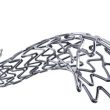Peripheral vascular diseases affect over 20% of the population and can affect up to 30% of people with cardiovascular risk factors. The most important treatment points include modification of risk factors, exercise, optimal medical treatment, and timely revascularization. Given its lower risk of peri-procedural complications (when compared to surgery), endovascular therapy is generally the first<a href="https://solaci.org/en/2017/08/14/different-techniques-for-the-improvement-of-outcomes-in-intermittent-claudication/" title="Read more" >...</a>
Clinical Significance of Collaterals in Chronic Total Occlusions
Collateral circulation develops during the gradual progression of coronary occlusions in order to replace the original artery and supply blood to areas jeopardized by ischemia. However, the relevance of collaterals has remained controversial for many years. Several works have suggested a rapid regression of collaterals after rechanneling of chronic total coronary occlusions, which could render<a href="https://solaci.org/en/2017/08/08/clinical-significance-of-collaterals-in-chronic-total-occlusions/" title="Read more" >...</a>
Statin Pre-Treatment for the Prevention of Peri-Procedural Events in Carotid Artery Stenting
Recent randomized studies have shown that the rates of combined peri-procedural events for carotid artery stenting and carotid endarterectomy are similar. While the final numbers are similar, the actual events are different: more infarction events for endarterectomy and more stroke (particularly minor stroke) events for carotid artery stenting. The reduction of these rates of stroke has been the aim of<a href="https://solaci.org/en/2017/07/31/statin-pre-treatment-for-the-prevention-of-peri-procedural-events-in-carotid-artery-stenting/" title="Read more" >...</a>
Glycemic control and risk of repeat revascularization
The association between glycemic control after coronary angioplasty and outcomes of the latter is controversial in many studies. We have come to think that the risk lies in suffering from diabetes, as if it was an unmodifiable factor. We have also come to believe that glycemic control can impact microvascular complications while it cannot do<a href="https://solaci.org/en/2017/07/12/glycemic-control-and-risk-of-repeat-revascularization/" title="Read more" >...</a>
The use of IVUS in unprotected left main PCI associated to better outcomes, compared to angiography guided PCI
Courtesy of Dr. Gustavo Leiva. Coronary Artery Bypass Graft (CABG) has traditionally been the procedure of choice in patients with left main coronary artery disease. However, the use of percutaneous techniques in this kind of lesions has been on the rise, partly due to recent research showing similar outcomes with both procedures. Unprotected left main<a href="https://solaci.org/en/2017/06/26/the-use-of-ivus-in-unprotected-left-main-pci-associated-to-better-outcomes-compared-to-angiography-guided-pci/" title="Read more" >...</a>
Everolimus DES are more effective and less costly than conventional BMS
Courtesy of Dr. Guillermo Migliaro. Drug eluting stents (DES) represented the greatest technological advance in the treatment of instent restenosis from conventional metallic stents (BMS), especially cobalt chromium everolimus eluting stents (CoCr EES), which have shown an excellent profile, and are mostly safer, compared to first generation DES. Indeed, several randomized studies and meta-analyzis have<a href="https://solaci.org/en/2017/06/16/everolimus-des-are-more-effective-and-less-costly-than-conventional-bms/" title="Read more" >...</a>
Angioplasty in lesions due to radiation treatment presents similar mortality rates
Courtesy of Dr. Carlos Fava. Thoracic radiation causes cardiac lesions, and coronary arteries are among the most affected structures. Furthermore, it provokes obstructive lesions due to wall fibrosis. Generally, patients with this background are not eligible for surgery and receive angioplasty, a seemingly great alternative. However, there is no clear information on outcomes yet. This<a href="https://solaci.org/en/2017/06/07/angioplasty-in-lesions-due-to-radiation-treatment-presents-similar-mortality-rates/" title="Read more" >...</a>
VIVA Post-Market Study: More Evidence for the Valve-in-Valve Technique
Courtesy of the SBHCI. Bioprosthetic surgically-implanted valves degenerate over time, while patients become too old and are at high risk for reoperation. Transcatheter aortic valve implantation inside a deteriorated surgically-implanted valve (a valve-in-valve procedure) is an emerging alternative. The VIVA trial was designed to offer systematic and prospective data from patients treated with<a href="https://solaci.org/en/2017/05/30/viva-post-market-study-more-evidence-for-the-valve-in-valve-technique/" title="Read more" >...</a>
EVOLVE II: Diabetes Substudy: Results at 3 Years after the SYNERGY Stent in Diabetics
Courtesy of SBHCI Diabetic patients have worse evolution after coronary PCI. Drug eluting stents with bioresorbable polymers were designed to facilitate arterial healing, and reduce inflammation and late and very late thrombosis risk. This sub-study of diabetic EVOLVE II patients presents the 3 year outcomes of the SYNERGY stent. The EVOLVE II included<a href="https://solaci.org/en/2017/05/25/evolve-ii-diabetes-substudy-results-at-3-years-after-the-synergy-stent-in-diabetics/" title="Read more" >...</a>
CENTERA: Results of the New Self-Expandable Valve
This new device offers the advantage of a lower frame height, which reduces the chance of coronary occlusion. The delivery system is totally motorized and the valve can be repositioned. In addition, the sheath is “14 F” for all valve sizes (23, 26 and 29mm). 203 patients were included, all with severe aortic stenosis<a href="https://solaci.org/en/2017/05/25/centera-results-of-the-new-self-expandable-valve/" title="Read more" >...</a>









